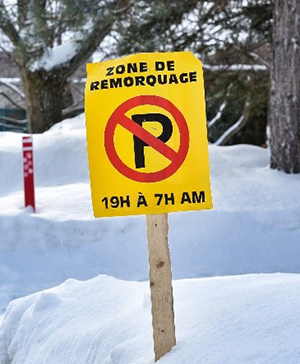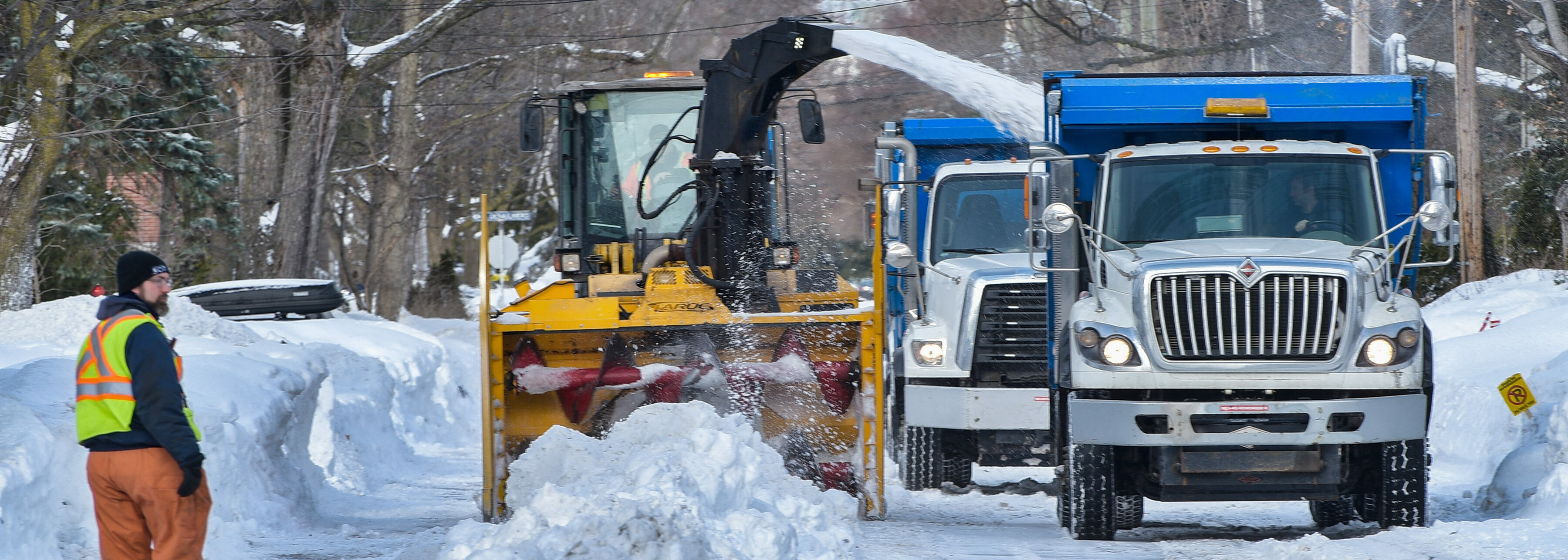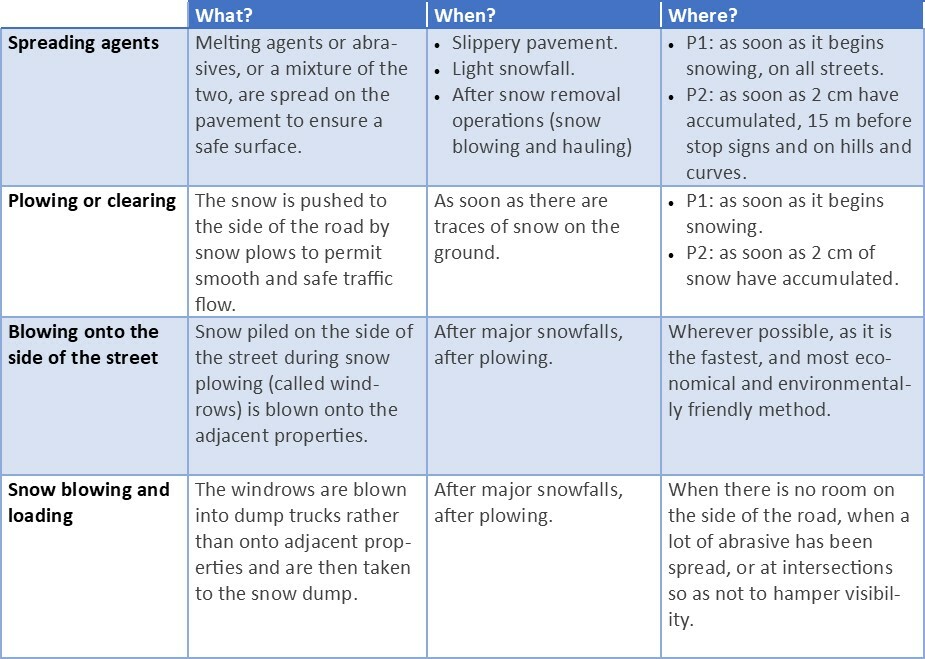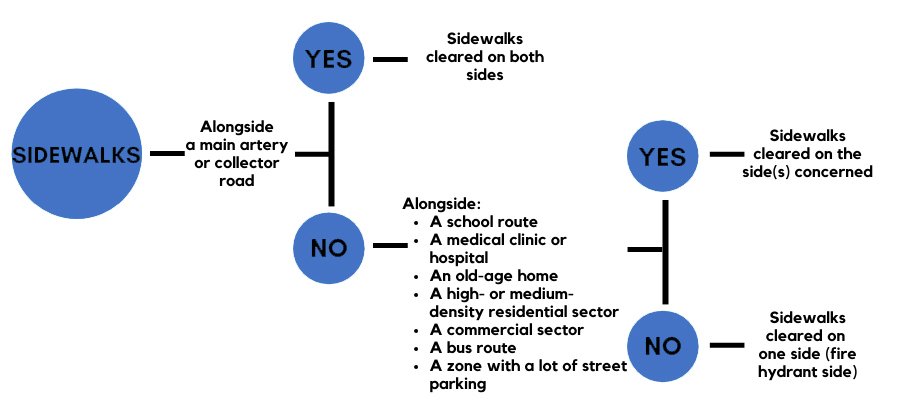Snow removal
Overnight street parking is permitted from December 1 to March 31, unless prohibited by parking signs or when a snow removal alert is in effect. In this case, parking on the streets between midnight and 5:30 a.m. is prohibited throughout the entire municipality, WITHOUT EXCEPTION.
It is your responsibility to find out if a snow removal operation is planned.
Towing
If your vehicle is parked on the street and is likely to interfere with snow removal, it may be ticketed and towed. The car will be towed at Seaway Park.
The City notifies the public no later than 4 p.m. that an alert is in effect or has been lifted. There are a number of ways to find out:
- Call the Info-snow removal line at 450-466-3788;
- Consult the website (look for the alert banner on the home page) and our social media;
Sign up for our text alerts at alertes-deneigement@saint-lambert.ca indicating your first and last name, your cell phone number and whether you would like to receive them in English or French. As of November 25, 2024, the bciti+ platform will be deactivated and will no longer be accessible. If you were subscribed to these alerts, you will have to re-subscribe to the new temporary alerts, as we do not have access to the list of people who were subscribed to them.
During the no-parking period, alternative parking options are available.
Public parking lots:
- City Hall (55 Argyle Avenue)
- Notre-Dame Street parking lot (between Aberdeen and Green streets)
- Maison Desaulniers (574 Notre-Dame Avenue)
- Elm Street parking lot (behind the Caisse Desjardins)
- Saint-Laurent Street parking lot (between Prince Arthur Street and Victoria Avenue)
- Saint-Denis Park (across from 31-35 Fort Avenue)
- Recreation centre (600 Oak Avenue)
- Lespérance Park (near the tennis courts)
- Seaway Park (430 Riverside Drive)
On-street parking (in the parking lots and not on the road) :
- Riverside Drive (between Rhône Avenue and 7 Simard Boulevard)
- Notre Dame Avenue (between Hooper and Green streets) -- In the parking lot
- Mercille Avenue (between Hooper and Green streets)
- Hooper Street (between Notre-Dame and Mercille avenues)
- Elm Street (near Victoria Avenue) -- In the parking lot (8 places)
- Du Golf Street (near the municipal golf course)
- De Navarre Park
You must observe the indications on the signs for each parking area.

If no snow removal operation is in effect, overnight street parking is permitted between midnight and 5:30 a.m., except in permanent no-parking zones.
Also, pay attention to temporary no-parking signs (stuck in snow banks) to keep the streets clear for one-time snow removal operations.
How to facilitate operations
You can assist our snow removal teams and help operations run smoothly by adopting certain behaviours.
Always place your waste bins in your driveway, not on the street or sidewalk, so that snow clearing vehicles can get around more easily. If possible, remove your bins as soon as they have been emptied. When there are obstacles on the sidewalk or vehicles parked too close to the sidewalk, equipment operators have to skirt around them by moving off the sidewalk, which means poorer snow clearing.
When you are clearing the snow off your driveway, you must pile it on your own property so that pedestrians and vehicles can get around safely. If a contractor does your snow removal, you are responsible for telling him that he must deposit the snow on your property and make sure that none is left in the street or on the sidewalk.
By obeying the parking restrictions, you allow snow removal vehicles to travel freely along the streets and clear the snow efficiently.
Spreading anti-icing agents, plowing, snow blowing, loading, etc. are different operations carried out during snow removal. We will keep you regularly informed during the winter when major operations are going to take place in our city so that you can help us ensure that they go smoothly, for example, by removing your car from the street.
Consult the Snow removal logistics section below to learn more about the various operations and how they are carried out.

Snow removal logistics
Snow removal is a complex logistical operation that is carried out in several steps and according to certain priorities. These steps are carefully planned in light of the weather reports received and begin as soon as it starts snowing.
Despite careful planning, many factors can influence snow removal logistics and how long the operations last:
- the type of precipitation (snow, ice, freezing rain, blowing snow, mixed precipitation);
- new precipitation before the end of the operations already under way;
- extreme temperatures (extreme cold, spring temperatures mid-season);
- when the precipitation falls (during rush hour or at night);
- citizens’ behaviours;
- equipment breakdown;
- limited driving time to ensure the safety of both employees and the public.
This means that if snow falls during operations, the intervention time and operational priorities revert to zero. The teams resume snow removal operations by prioritizing the main arteries and collector streets, followed by local streets.
Snow removal operations are planned in accordance with our snow removal policy. The overriding aim is safety. That is why our streets are prioritized for clearing by their level of importance in maintaining essential services.
- Priority 1 (P1): roads where there is heavier traffic, i.e. main arteries, roads leading to hospitals, collector streets and roads on school routes.
- Priority 2 (P2): local streets in residential sectors.
Saint-Lambert territory

We have our own snow removal teams in Saint-Lambert. At the peak of a snowstorm, more than 30 vehicles and 40 employees are dispatched over several work shifts to clear the streets. These numbers exclude the private truck drivers who help us out with loading and hauling. The snow removal routes they follow are planned in a way that ensures your safety, efficient operations and the shortest possible intervention times.
Spreading of melting agents/abrasives and plowing
As soon as any traces of snow appear on the ground, our teams get into action to spread melting agents or abrasives and to plow P1 streets. If there is an accumulation of 2 cm, they then tackle P2 streets. Melting agents are spread on P2 streets only 15 m before stop signs and on hills and curves.
Intervention times
Intervention timesAfter leaving the municipal garage, the teams take from 5 to 7 hours to perform a first snow clearing operation on all P1 roads and streets, and from 7 to 10 hours on P2 streets, when there is less than 30 cm of snow. If the snow keeps accumulating, the snow clearing work continues until the end of the precipitation. When the snow clearing vehicles pass a second time, they only spread melting agents as needed in order to limit the use of abrasives, which are harmful for the environment.

Snow removal (snow blowing and loading)
Once the snow has stopped, if necessary, the teams begin snow removal operations. This type of operation is carried out only after an accumulation of around 10 cm. Wherever possible, snow that has been pushed to the side of the road is blown onto the adjacent properties as this is much faster, more economical and more environmentally friendly than blowing the snow into trucks.
Intervention times
The duration of a snow removal cycle depends on the amount and type of snowfall.

In summary

As soon as any snow has accumulated on the ground, crews start spreading abrasives and clearing sidewalks in the same order of street priority. However, to optimize operations not all sidewalks are cleared.

Intervention times
For a snow accumulation of less than 15 cm, it takes approximately 8 hours for our teams to clear all the sidewalks. Generally speaking, the operations are planned to ensure that sidewalks are cleared by 7 a.m. in the morning to allow pedestrians to walk safely, whether to school, work or the bus stop.
When more than 30 cm of snow have fallen, only the sidewalks along the main arteries are cleared to begin with. In some cases, during major snowstorms, we may even have to pile snow on the sidewalks to ensure a wide enough road space for emergency vehicles to get through. This type of situation is only temporary, and the sidewalks will then be cleared as soon as possible.